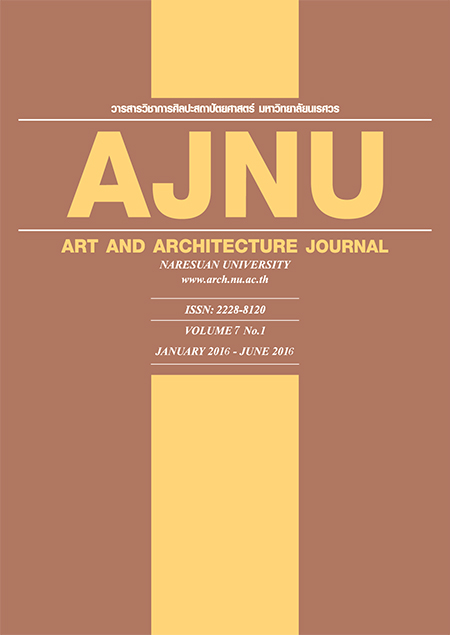การก่อรูปในลวดลายมัดหมี่
Main Article Content
Abstract
เมื่อประมาณ 4,000 ปีมาแล้วในยุคหินใหม่ บรรพชนได้คิดค้นเทคนิคการมัดย้อมแบบมัดหมี่ขึ้นซึ่งเป็นเทคนิคการสร้าง
ลวดลายให้กับผ้าทอมือที่เกิดจากการนำเส้นไหมหรือฝ้ายมามัดให้เกิดลวดลายก่อนการย้อมสี จากนั้นจึงนำเส้นด้ายเหล่านั้นมาทอ
เป็นผืนผ้า โดยการก่อรูปของลายมัดหมี่ของภูมิปัญญาท้องถิ่น กรณีหมี่ซิ่นแบบหมี่ลวดจะมีการออกแบบวางลายจากแม่ลาย
เดียวกันให้มีรูปแบบต่างกันโดยอาศัยการซ้ำ โดยการกำหนดทิศทางและขนาดของลาย สามารถทำได้ 2 ขั้นตอน ได้แก่ ขั้นตอน
ที่ 1 การเตรียมเส้นพุ่งโดยการค้นหมี่ที่เครื่องโยกหมี่ และขั้นตอนที่ 2 การมัดหมี่ โดยทั้งสองขั้นตอนมีความสัมพันธ์กันและภูมิ
ปัญญาท้องถิ่นใช้ระบบมโนทัศน์สำหรับการผลิต ซึ่งทั้งสองขั้นตอนมีผลต่อการก่อรูปของลายมัดหมี่ กล่าวคือ การเตรียมเส้นพุ่ง
แบบหมี่ล่ายทำให้เกิดการก่อรูปของลายแบบวางลายตั้งขึ้นในทิศทางเดียวกันตลอดทั้งผืนผ้า แต่การเตรียมเส้นพุ่งแบบหมี่ลวด ทำ
ให้เกิดการก่อรูปของลายแบบภาพสะท้อนกลับตลอดทั้งผืนผ้า หากนักออกแบบเข้าใจกระบวนการดังกล่าวจะสามารถสร้างสรรค์
งานใหม่ได้
About 4,000 years ago in the Neolithic period, human ancestors invented the tie-dye technique
called ikat (Mud-Mee) which is the technique producing patterns in hand woven cloths by tying parts of silk
or cotton yarns to create the patterns before dyeing them then using those yarns to weave a piece of cloth.
The local wisdom was used in forming the ikat patterns. In the case of ikat wrap-around cloth called Mee-
Ruat (one step tie dye), the same pattern was designed and utilized repeatedly in the different forms by
setting different directions and sizes of the pattern. It can be done in 2 steps: 1) preparing weft yarns by
stretching them using a yarn tension device, and 2) tie-dyeing. Both steps are related and the local wisdom
regarding the manufacturing concept system was employed. Both steps affected on the formation of ikat
patterns. In summary, preparing the weft yarns of Mee-Lai formed the pattern in the vertical direction
throughout the cloth. However, preparing the weft yarns of Mee-Ruat formed created mirror images or
patterns throughout the cloth. If designers understand the process, it will create new designs.

